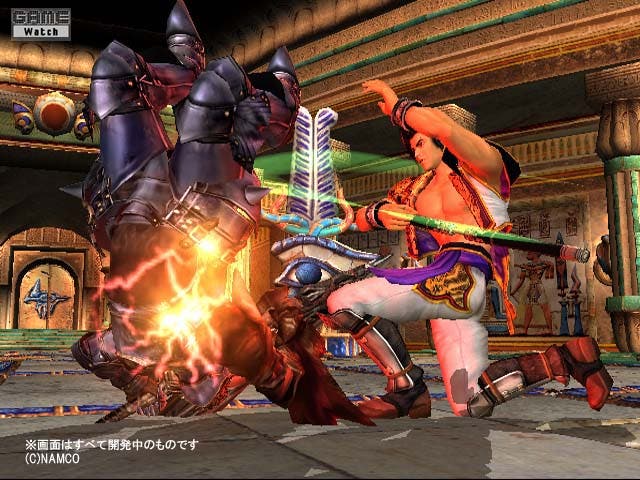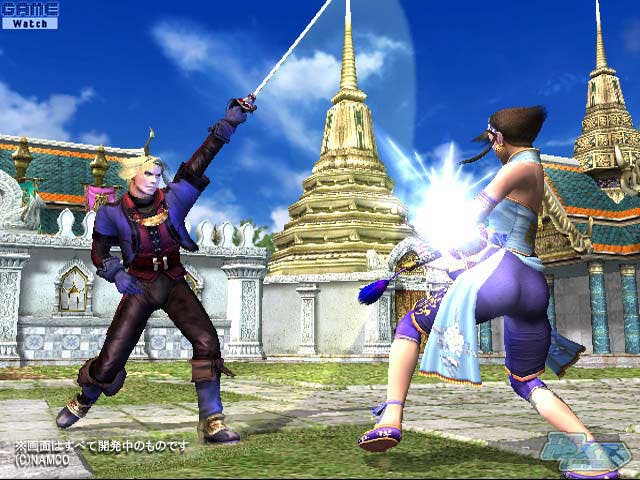Soul Calibur II
It's been a long time coming, and it's almost available in Japanese arcades

2.0 Calibur
Soul Calibur II is faster to play, but Namco has been careful not to implement changes at the expense of the carefully protected gameplay balance. Despite the change of pace, veterans of the original should feel right at home with the classic four-button control system of high and low attacks, kick and block, and the new charging moves are equally simple. By clutching all three attack buttons simultaneously, characters are doused in glitzy lighting effects and able to unleash a flurry of brutal moves - almost like the transition between bloke and beast in Bloody Roar - and although there is no actual claret involved, the whole of the game is so fastidiously violent that an adult certification is almost guaranteed.
Naturally, charging and simple attacks aren't the only weapons at a player's disposal. The full fighting complement of characters for this outing is Ivy, Mitsuragi, Astoroth, Maxi, Cassandra, Kilik, Xianghua, Nightmare, Taki, Voldo and Talim, and the game retains many of its best special moves, along with several new ones for each of the returning characters. Some of these old attacks have seen a little refinement, including Xianghua's throws, but most of the changes are aesthetic.
The game also boasts four new characters, two of whom are entirely original within the context of the Soul games, and two of whom replace fighters whose storylines in the first Soul Calibur made a return impossible. Raphael is the first of the newbies, a fencing genius from Europe with a thin blade, crafty moves and a good fencer's reach. He is said to be both nimble and fleet of foot, and perfectly capable of outmuscling the bigger characters when called upon. His fellow debutant is Talim, whose name perhaps masks her gender, and whose origin is Asian (perhaps India). She attacks with twin blades and also has a good reach, but she is also generally strong and very quick. Less-than-new new characters have been brought in to replace Hwang and Sophitia. Hwang's understudy is named Yunsung, whilst Sophitia's double is actually her younger sister Cassandra. Neither character is "new" per se, as they both mostly recycle their counterpart's selection of moves, but as with the rest of the fighter selection, they boast a number of new attacks.

Main Event
Apart from Raphael, Talim, Yunsung and Cassandra, no new characters are promised, despite widespread rumours about secret, unlockable characters such as Link and Fox McCloud, both of whom are highly unlikely additions. Namco hasn't officially denied these reports, or news that test version arcade cabinets seem to include PlayStation 2 memory card slots. We should learn more about that after the game's July 5th release date in Japan. And while we're commenting on rumours; Soul Calibur II bossman Hiroaki Yotoriyama of Namco has mentioned that the series could one day appear on the GameBoy Advance, although this does not mean that SCII will interact in any way with Nintendo's handheld.
But the real reason that a lot of people will tune in for news on Soul Calibur II is to hear how it's shaping up from a purely aesthetic point of view. If you would like some good news, Voldo has lost his spike, although he becomes a lot stretchier and smoother in this game; like a cross between Street Fighter's Dhalsim and Victor Tooms from the X-Files. Character detail in general has been upped considerably, with higher polygon counts and more obvious geometry, not to mention prettier outfits, even if the ladies aren't exactly Dead or Alive Volleyball material.
It's not just the characters that Namco has given body to, either. Everything in the game seems to have texture and looks lumpy, as you might expect it to in real life. There are few if any flat surfaces on display, and every stage has a lot more depth of detail around the ring, with windows that let you peer out into the countryside or wherever you happen to be fighting, and otherwise just enormous rolling landscapes and delicate, wholly superfluous bits of detail which merge into a wonderful spectacle. And while some stages are simply barren arenas and there is no DOA-style destructible scenery or free-roaming to involve players with their sumptuous surroundings, other stages feature obstacles which can influence battle strategy and walls against which players can be pinned, meaning victory in the same way as the more traditional ring outs. Completing the puzzle are elements of lighting and shadow that improve on everything we've seen to date in a beat 'em up. Self-shadowing on character models may be too subtle to spot at speed, but in your mind's eye it will contribute to a better overall picture, and slow-motion replays should benefit noticeably.
Conclusion
Soul Calibur II could well find itself facing criticism for not breaking free of its roots and producing another graphical quantum leap, but the truth is that the first Soul Calibur was so far ahead of its competition at the time that it stands up to scrutiny even today, with the likes of Dead or Alive 3 and Tekken 4 its adopted contemporaries. The fact is that Soul Calibur looks great, and the sequel builds on that with layer upon layer of detail and an array of honourable additions that reads like a wishlist.
Soul Calibur II is due out on all three leading consoles in 2003, and whichever has the best version, it could make as much difference to that console as a full-blown triple-A exclusive.




.png?width=291&height=164&fit=crop&quality=80&format=jpg&auto=webp)



